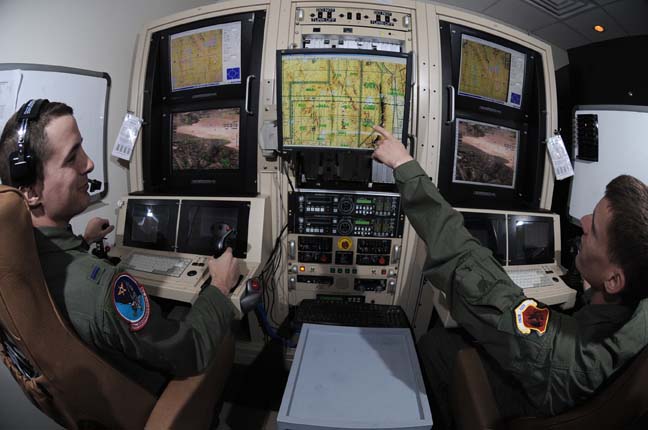At the official rollout of the Air Force’s new Unmanned Aerial System Flight Plan 2009-2047, Thursday afternoon, the service’s vice chief of staff, Gen. William Fraser, acknowledged that most focus on UAS operations is on the unmanned aerial vehicle itself, but he said, “While the operator may not be sitting in the cockpit, at the heart of these unmanned systems, and really at the core of all of our missions, are highly skilled airmen.” (Read our initial coverage, which reports the shift to a future in which UAVs are dominant.) UAS task force commander, Col. Eric Mathewson, cast a slightly different light when he said that one of the strengths of UAVs is its “1-G cockpit,” the ground control station in which he “can always have a fresh crew, which enables any sort of persistence.” Gen. Dave Deptula, the Air Staff’s intelligence-surveillance-reconnaissance czar, called that persistence capability “first among equals.” He said, “What UAS is bringing to the table is the ability to stay in position or maneuver over large areas for a long period of time, and that’s where a person in an aircraft becomes a limitation.” The Air Force flight plan, they say, is meant to institutionalize USAF’s vision for developing and resourcing unmanned capabilities for the foreseeable future. Deptula noted: “We are today, with unmanned aerial systems, about where we were in the 1920s with manned aircraft. Lots of potential out there. And, we have to change the way that we think about using these systems across the entire spectrum of military operations.” Mathewson said the document does not lay out specific solutions but rather “concepts and possibilities” that will be filled in as the service talks with industry, academia, the other services, and allies. Initiatives underway include the development of multi-aircraft control by a single pilot (currently undergoing testing at Creech AFB, Nev., according to Mathewson) and a “payload agnostic platform” or a modular platform that could accommodate different payloads to perform a range of missions, from ISR to mobility and strike. “We’re thinking about multi-mission in the large sense,” he said and added, “We think this is potentially where we are going to go.” (Deptula briefing slides)(Mathewson briefing slides) (Air Force UAS flight plan) (Briefing transcript)
the official rollout of the Air Force’s new Unmanned Aerial System Flight Plan 2009-2047, Thursday afternoon, the service’s vice chief of staff, Gen. William Fraser, acknowledged that most focus on UAS operations is on the unmanned aerial vehicle itself, but he said, “While the operator may not be sitting in the cockpit, at the heart of these unmanned systems, and really at the core of all of our missions, are highly skilled airmen.” (Read our initial coverage, which reports the shift to a future in which UAVs are dominant.) UAS task force commander, Col. Eric Mathewson, cast a slightly different light when he said that one of the strengths of UAVs is its “1-G cockpit,” the ground control station in which he “can always have a fresh crew, which enables any sort of persistence.” Gen. Dave Deptula, the Air Staff’s intelligence-surveillance-reconnaissance czar, called that persistence capability “first among equals.” He said, “What UAS is bringing to the table is the ability to stay in position or maneuver over large areas for a long period of time, and that’s where a person in an aircraft becomes a limitation.” The Air Force flight plan, they say, is meant to institutionalize USAF’s vision for developing and resourcing unmanned capabilities for the foreseeable future. Deptula noted: “We are today, with unmanned aerial systems, about where we were in the 1920s with manned aircraft. Lots of potential out there. And, we have to change the way that we think about using these systems across the entire spectrum of military operations.” Mathewson said the document does not lay out specific solutions but rather “concepts and possibilities” that will be filled in as the service talks with industry, academia, the other services, and allies. Initiatives underway include the development of multi-aircraft control by a single pilot (currently undergoing testing at Creech AFB, Nev., according to Mathewson) and a “payload agnostic platform” or a modular platform that could accommodate different payloads to perform a range of missions, from ISR to mobility and strike. “We’re thinking about multi-mission in the large sense,” he said and added, “We think this is potentially where we are going to go.” (Deptula briefing slides)(Mathewson briefing slides) (Air Force UAS flight plan) (Briefing transcript)
Air Force Gen. Alexus G. Grynkewich assumed command of U.S. European Command on July 1, taking over the key assignment as the U.S. and its allies contend with a resurgent Russia and a grinding war in Ukraine.
